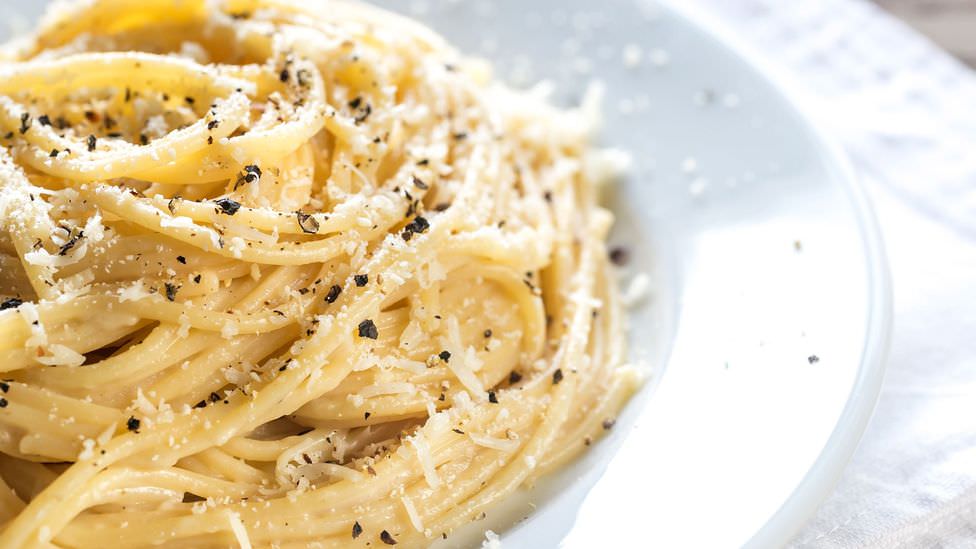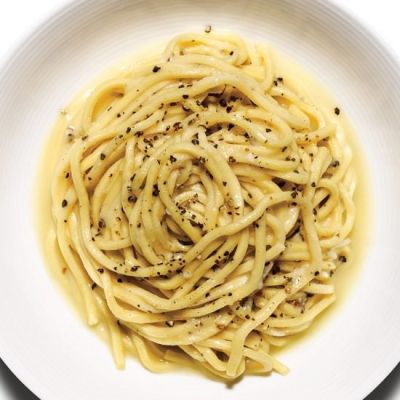In this column we share the cuisine and recipes of Italy and our Italian American communities. Each month we feature recipes curated from our research and those shared by LGI readers.
Food and cooking are important aspects of our cultural identity and sharing recipes is one way for us to connect to our roots and to one another!
We invite you to share your family recipes and the stories behind them with us! We would like to feature your special dishes, so if you have a recipe, we would love to hear from you! Please email your recipes and photos to This email address is being protected from spambots. You need JavaScript enabled to view it. before October 10.
This creamy Italian pasta recipe is shared by contributing writer Joni Lucarino. Joni's tips and tricks will help you to create the most tasty dish!
Cacio e Pepe
dalla cucina di Joni Lucarino
The Holy Trinity of Italian pasta, specifically Roman, is Carbonara, Amatriciana, and Cacio e Pepe. Starting back in the mid-20th century, from the agricultural Roman society, when the shepherds would be traveling on foot for days, they would carry local sheep’s milk cheese, dried pasta, pepper and guanciale with them. The dishes produced from those simple ingredients became known as “la cucina povera”, peasant food. These pasta dishes are now a staple in most Italian kitchens.
One can find many recipes for Cacio e Pepe by many who claim to have found the secret to preparing the perfect creamy pasta dish. The trick is patience, practice and finding what works for you. While in Rome last month, I had to have it and see just how good it really was. It did not disappoint.
The creaminess of this dish comes not from milk, but from the reserved pasta water and the fresh and finely grated Pecorino Romano cheese combined at a certain temperature in a certain manner. This simple recipe of few ingredients may not be simple to make but once mastered it will become a staple in your kitchen as well.
Traditionally Cacio e Pepe was made with a hand-made tonnarelli pasta which is double the thickness of classic spaghetti. A bronze-die-cut bucatini pasta makes a good substitute. This dish calls for a “toothy” pasta to hang onto the creamy sauce.
From my research, I have come up with some valuable tips that would apply to any recipe you choose to follow:
- To boil the pasta: 2 cups water for every 100 g (3.5 oz) pasta to have a starchy water. This would be hard for me to do as I typically like to use a lot of water! I also recommend starting with making one or two servings till you master the sauce.
- After the pasta is cooked al dente (firm to the bite), you will reserve 1 1/4 cups pasta water and let it cool a few minutes before adding to the sauce.
- Prior to doing anything, freshly grate Pecorino Romano cheese on the finest setting of a box grater. This is imperative.
- Do not add the cheese all at once when making the sauce but do it gradually.
- The black peppercorns should be freshly and coarsely ground and should be toasted to “bloom” the pepper.
- Don’t hurry the process, whisk the cheese sauce slowlyand constantly over low heat.
- You should only use Pecorino Romano cheese imported from Italy. It is a more flavorful, sharper, tangier cheese than Parmigiano Reggiano.
Ingredients:
8 oz. Pasta (such as Bucatini)
1 ½ C. Imported Pecorino Romano cheese, finely grated
50 coarse grinds (1 tsp. or more) Freshly cracked, black peppercorns
1 T. Extra-virgin olive oil (the tastiest you can find and afford)
3 T. Unsalted butter
Salt for the pasta water
Directions:
Boil the pasta in a large stockpot, until it is al dente, in less water than usual. While the pasta cooks start the sauce. In a very large skillet, melt the olive oil and butter and add the cracked pepper, toasting about a minute to “bloom” the pepper flavor. Reserve 1 ¼ cups pasta water before draining the pasta and let it cool for 3 minutes. Set the pasta aside. Slowly whisk in one cup pasta water into the butter mix while the pan is off the heat and let it stand for 3 minutes. Over low heat, gradually add the grated cheese, whisking constantly for up to 5 minutes or so until you have a smooth, velvety sauce. Add the cooked pasta to the sauce pan one half at a time, tossing thoroughly to coat. You can adjust the creaminess of the sauce by either simmering it more if it’s too liquidy or by adding more pasta water if it’s too dry. Garnish with more pepper and freshly grated cheese and serve immediately.




